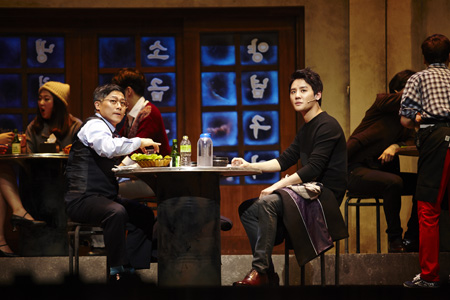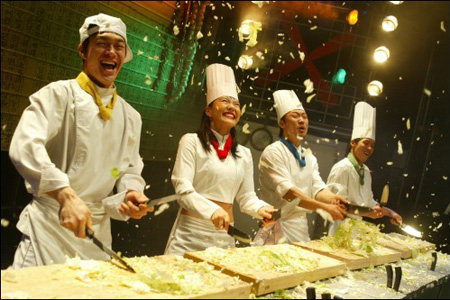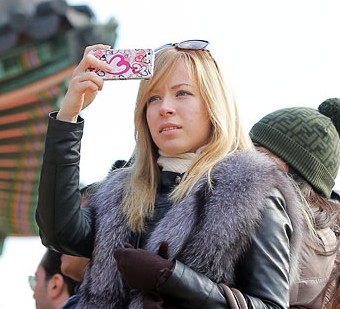- California Assembly OKs highest minimum wage in nation
- S. Korea unveils first graphic cigarette warnings
- US joins with South Korea, Japan in bid to deter North Korea
- LPGA golfer Chun In-gee finally back in action
- S. Korea won’t be top seed in final World Cup qualification round
- US men’s soccer misses 2nd straight Olympics
- US back on track in qualifying with 4-0 win over Guatemala
- High-intensity workout injuries spawn cottage industry
- CDC expands range of Zika mosquitoes into parts of Northeast
- Who knew? ‘The Walking Dead’ is helping families connect
Stage shows becoming tourist attractions in Seoul

Musical “December” starring K-pop star Kim Jun-su is drawing foreign tourists from Japan and China. (Courtesy of NEW)
Thanks to K-pop stars
By Chung Ah-young
Only 10 years ago, Korean performing arts were underappreciated both at home and abroad.
Back then, musicals coming from Broadway or the West End used to sell out theaters, but now, K-pop stars in the shows are becoming the most important factor for drawing in audiences, particularly foreign tourists.
Recently, “December,” a musical by theater and film director Jang Jin, based on the songs of the late singer Kim Kwang-seok, made waves among foreign tourists from Japan and China.
Produced by Next Entertainment World (NEW), the musical now being performed at the Sejong Center for the Performing Arts stars hallyu heartthrob Kim Jun-su, a member of the K-pop band JYJ, and Park Geon-hyeong, one of the country’s most sought-after musical actors. They are alternating the lead role in the show.
According to InterPark, the nation’s online ticketing site, foreign visitors take up 5.8 percent of the total audience in ticket reservations. But more than 50 percent of the tickets are sold to foreigners at the door because the venue is close to the tourist spots Jongno and Gwanghwamun.
“The information desk is always crowded with foreign tourists even when the show isn’t on,” an InterPark official said.
Also, “Three Musketeers,” which is on stage at Seongnam Arts Center in Gyeonggi Province, received the largest reservation share made by foreigners last year.
Three Musketeers is originally a Czech musical which was adapted into Korean with slightly changes in characters and choreography. It is one of the popular Czech originals here along with “Jack the Ripper,” which has become a Korean theatrical export to Japan.
InterPark Global Service and Visit Seoul, the major ticketing sites for overseas visitors, said that foreigners made the largest ticket reservations for the show last year because the musical offers various services such as interpretations, subtitles and foreign language services.
Also, the hallyu star-studded casting including Kyuhyun from Super Junior and Jun. K from 2PM and veteran musical actors such as Shin Sung-woo, Yoo Jun-sang and Uhm Ki-joon are the main driving force for the popularity of the musical.
A recent performance of “Joseph and the Amazing Technicolor Dreamcoat,” the Andrew Lloyd Webber-Tim Rice rock musical, won the Hallyu Awards in the musical category for its contribution to create a musical hallyu boom among foreign fans last month.
The musical has attracted public attention for the casting of K-pop singers Yang Yo-seap, a member of B2ST and Lim Si-wan from ZE:A.
The Korean theater market has thrived with American and European musicals. Producers are hiring K-pop stars and other celebrities at a high cost.
As young women in their teens and 20s to 30s, and Japanese and Chinese tourists make up the largest part of the audience, they are keeping the market growing.
The New York Times reported last month that producers focus on rotating big-name singers into musicals to help the shows run for longer.
“A few Korean theater producers are trying to ride this wave by putting K-pop stars into Broadway musicals and staging tours of the shows in Japan; a K-pop-laden ‘Jack the Ripper’ was a popular export to Tokyo in 2012. The ultimate goal is to bring these tours to China, once its enormous market opens up further to outside theatrical productions,” it reported.

“Cookin’,” better known as “Nanta,” a non-verbal comedy show, which was first put on stage in 1997, is likely to break the 10 million audience mark this year. (Korea Times file)
Non-verbal shows
The Korean theatrical scene is celebrating as “Cookin,” better known as “Nanta,” a non-verbal comedy show, which was first staged in 1997, is likely to break the 10 million audience mark this year. Credited as a hallyu initiator in the performing art scene, the show has been seen by about 1 million spectators every year, becoming a must-see performance for foreign tourists.
The show has made globe-trotting tours in 285 cities in 48 countries over the last 17 years. PMC Production operates exclusive theaters in Myeong-dong and Chungjeong-no in Seoul, on Jeju Island and Bangkok in Thailand. It is currently touring Japan — from last year through February.
In 2012, among the 11 million tourists visiting Korea, approximately 15 percent or 1.62 million watched Korean performances, including non-verbal shows, during their visit. And the trend is expected to continue as more theatrical producers cash in on K-pop stars in their productions.
Reflecting the soaring popularity of the theatrical arts here, the Korean thespians launched the Korea Performing Arts and Tourism Association last years in a bid to effectively connect Korean stage shows with tourism.
The members are mostly non-verbal performing arts troupes, which produce “Jump,” “Sachum” and “Bibap” among others. Currently, 16 non-verbal performances are being performed, particularly for foreign audiences.
To promote the Korean performing arts to foreign tourists, the association said that the Korea Grand Sale — a nationwide shopping festival, which kicked off on Jan. 3 and will continue through Feb. 16 — will be a great opportunity for the Korean performing arts industry to introduce their shows to foreigners.
“We can create a synergy effect by making great use of the Korea Grand Sale to attract more foreign tourists,” Choi Kwang-il, president of the association, said.
The association said the performing arts could play a crucial role in boosting tourism because it can diversify cultural content for tourists from typical programs such as shopping and visits to museums.
















Pingback: Interpark Global Tickets | nfl - sell your tickets